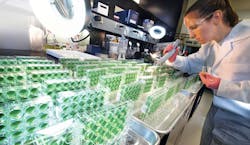Continuously optimizing manufacturing operations around concepts like OEE (overall equipment effectiveness) and Lean Manufacturing may seem outdated in the age of Industry 4.0, the Industrial Internet of Things and artificial intelligence. But the reality is that today’s new digital tools haven’t eliminated the need for these tried-and-true manufacturing improvement concepts, but they have made them easier to implement, scale and deliver more actionable results.
A good case in point for this was delivered at Siemens RealizeLive 2024 event in a session focusing on how Bayer Crop Science is scaling its OEE and Lean processes globally with the help of Siemens Opcenter Intelligence and Insights Hub (editor’s note: Insights Hub was formerly known as Mindsphere. See this article to learn more about the name change).
David Kaltmayer, director of manufacturing systems and products at Bayer Crop Science explained that the idea behind this OEE project was the realization that “digital Lean Manufacturing capabilities provide a new way of extracting continuous improvement from existing processes by extending traditional Lean practices. This allows manufacturing operations to accelerate delivery of value-added outcomes to the site, supply chain, customer and company.”
Project building blocks
Brandon Johnson with Engineering Industries eXcellence—the IT services and consulting firm that assisted Bayer Crop Science on this project—noted that this OEE project started with one Bayer Crop Science site in Constantine, Mich., with the idea of rolling it out to all the company’s row crop sites. It started by installing Siemens Opcenter Intelligence (data analytics software with built-in OEE capabilities) on premises at the site. “All the data we needed was available [from the equipment],” Johnson said. “We just had to connect it to an OPC server, collect the data and perform the OEE calculations.”
The basic structure of the technologies used by Bayer Crop Sciences for this project start with collecting data from equipment and connecting it to an OPC server. From here, OPC Connector reads data from the OPC server and inserts into Siemens Insights Hub. As the data enters Insights Hub, Opcenter Intelligence digests and stores the Insights Hub data to calculate the KPIs (key performance indicators). Bayer Crop Sciences’ operator screens chart the KPIs with data from Opcenter Intelligence and Insights Hub via application programming interfaces (APIs).
In 2021, Bayer Crop Sciences deployed this project across 36 sites to gain real-time access to data from more than 400 processing lines.
Results achieved to date
This project has provided Bayer Crop Science with a globally aligned time model and KPI algorithms across the sites where it has been deployed with localized language options and common dashboards and analytics, according to Kaltmayer. It also provided a means for focused change management and created an “OEE community” at the company with a focus on adherence to the company’s network blueprint and manufacturing security, he added.
Kaltmayer outlined four key results of this project:
- Helped Bayer Crop Science understand the sources of loss within bottlenecks, as well as downtime, speed and quality losses. One result of this shared by Kaltmayer included 6.5 million euros in packaging savings in the company’s Brazil row crops operations.
- Increased overall awareness of operational bottlenecks and equipment inefficiencies has led to more specific targeting of Lean and process improvement efforts.
- Established operational targets aligned with Bayer Crop Science’s OnePSS (product supply system) via real-time KPI and data aggregation.
- Enabled Bayer Crop Sciences digital transformation journey by ensuring the success of data-driven decisions, enabling a virtual factory and populating the company’s Crop Science data warehouse.
Challenges resolved and ongoing
As with any new technology implementation, whether it’s on-premises or delivered via SaaS, there will be process issues to work through to deliver success. This project at Bayer Crop Science is no exception to this reality.
Johnson noted that the first challenge faced dealt with managing global requirements and expectations as the software was rolled out to multiple sites. The solution, he said, involved Bayer organizing global OEE meetings with stakeholders in every region along with continued training of power users to investigate issues before escalating them to support.
Another challenge revolved around data recovery when connectivity between the OPC server and Insights Hub is lost. In these cases, the question became: How is data generated during that time recovered to avoid gaps in the OEE record? According to Johnson, the solution to this involved adding an integration point to a local on-premises historian. This closed any gaps with Insights Hub and Opcenter Intelligence.
Though these two challenges have been resolved, Johnson said two other ongoing challenges include:
- Data retention—teams are evaluating how long historical data should be retained, what data should be retained and how granular the archived data should be.
- Expanding manual data input at low automation sites. Here, Johnson noted that the project has been rolled out to Bayer Crop Sciences with “strong automation”, but they’re still working on implementing this at facilities considered to be “low automation” sites.
The company’s plans are now focused on expanding this project into those low automation sites, as well as revisiting older dashboards and user interface screens across the sites.
Johnson noted that this project has been rolled out to more than 40 Bayer Crop Science sites, with the goal of rolling it out to 80 sites.
Leaders relevant to this article:





